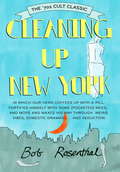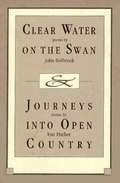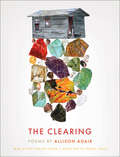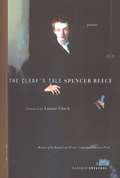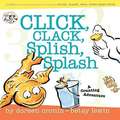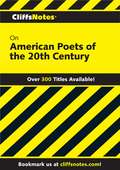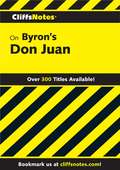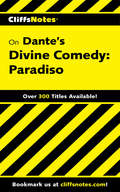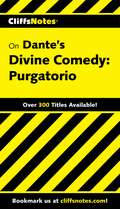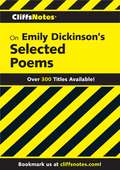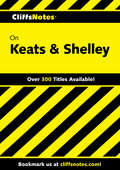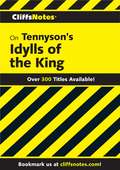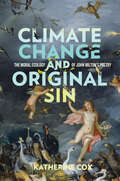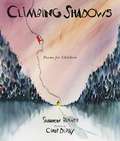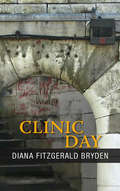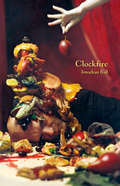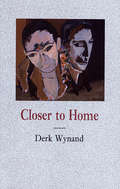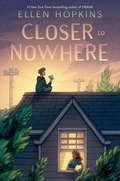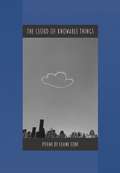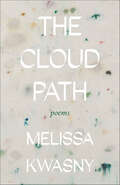- Table View
- List View
Cleaning Up New York
by Bob RosenthalTHE EAST VILLAGE, NYC, 1976.A 26-year-old starving poet needs $60. What else to do but register with a temp agency as a house cleaner? The excitement never wanes as he is catapulted into the everyday yet unimaginable worlds behind closed (apartment) doors. Bob knows one thing: the dirt will always win. Clients are a bit more unpredictable, he discovers, as he comes to terms with eccentric domestic habits and strange discoveries. When Bob becomes a weekly fixture in his clients' lives, anything can happen, and does, including a memorable encounter with an obliging Hoover that ultimately proves unable to get the job done. Cleaning Up New York has been a cult classic since it was first published in 1976 in an edition of 750.
Clear Water on the Swan: Stories
by Ron Fischer John HolbrookThis volume is published by the Montana Arts Council as the winning selection in the 1991 First Book Award Competition.
The Clearing: Poems (Max Ritvo Poetry Prize Ser.)
by Allison AdairA poetry debut that&’s &“a lush, lyrical book about a world where women are meant to carry things to safety and men leave decisively&” (Henri Cole). Luminous and electric from the first line to the last, Allison Adair&’s debut collection navigates the ever-shifting poles of violence and vulnerability with a singular incisiveness and a rich imagination. The women in these poems live in places that have been excavated for gold and precious ores, and they understand the nature of being hollowed out. From the midst of the Civil War to our current era, Adair charts fairy tales that are painfully familiar, never forgetting that violence is often accompanied by tenderness. Here we wonder, &“What if this time instead of crumbs the girl drops / teeth, her own, what else does she have&”?The Clearing knows the dirt beneath our nails, both alone and as a country, and pries it gently loose until we remember something of who we are, &“from before . . . from a similar injury or kiss.&” There is a dark beauty in this work, and Adair is a skilled stenographer of the silences around which we orbit. Described by Henri Cole as &“haunting and dirt caked,&” her unromantic poems of girlhood, nature, and family linger with an uncommon, unsettling resonance.Winner of the 2019 Max Ritvo Poetry PrizePraise for The Clearing &“A dark and bodily nod to folk- and fairy-tale energy.&” —Boston Globe &“The poems in Adair&’s debut draw on folklore and the animal world to assert feminist viewpoints and mortal terror in lush musical lines, as when &“A fat speckled spider sharpens / in the shoe of someone you need.&” —New York Times Book Review, &“New & Noteworthy Poetry&” &“Like Grimms&’ fairy tales, Adair&’s poems are dark without being bleak, hopeless, or disturbing. Readers will find the collections lush language and provocative imagery powerfully resonant.&” —Publishers Weekly (Starred Review)
The Clerk's Tale
by Spencer ReeceIn a recent double fiction issue, The New Yorker devoted the entire back page to a single poem, "The Clerk's Tale," by Spencer Reece. The poet who drew such unusual attention has a surprising background: for many years he has worked for Brooks Brothers, a fact that lends particular nuance to the title of his collection. The Clerk's Tale pays homage not only to Chaucer but to the clerks' brotherhood of service in the mall, where "the light is bright and artificial, / yet not dissimilar to that found in a Gothic cathedral." The fifty poems in The Clerk's Tale are exquisitely restrained, shot through with a longing for permanence, from the quasi-monastic life of two salesmen at Brooks Brothers to the poignant lingering light of a Miami dusk to the weight of geography on an empty Minnesota farm. Gluck describes them as having "an effect I have never quite seen before, half cocktail party, half passion play . . . We do not expect virtuosity as the outward form of soul-making, nor do we associate generosity and humanity with such sophistication of means, such polished intelligence . . . Much life has gone into the making of this art, much patient craft."
Clever Backbone
by John AgardIn Clever Backbone, the Guyanese-born word magician plays havoc with biology and makes a monkey out of Darwinian evolution -- on the occasion of the bicentenary of Charles Darwin's birth and the 150th anniversary of the publication of his Origin of Species.
Click, Clack, Splish, Splash: A Counting Adventure (A Click Clack Book)
by Doreen Cronin Betsy Lewin<p>Duck is about to trick poor Farmer Brown once again. While the farmer is sleeping the afternoon away, Duck and the other animals are planning a most unusual fishing trip. Sneaking past Farmer Brown is going to be as easy as 1, 2, 3! <p>This numerical adventure for the very youngest Duck fans brings counting books to a whole new level -- click, clack, splish, splash!</p>
CliffsNotes American Poets of the 20th Century
by Mary Ellen SnodgrassThis literary companion carries you into the lives and poetic lines of 41 of America's most admired poets from the last century. From popular favorites such as Robert Frost and Carl Sandburg to the more esoteric T. S. Eliot and Ezra Pound, this handbook also introduces you to living poets, such as Rita Dove, who are still inscribing their places in literary history. The book opens with an approach to analyzing poetry, and each author-specific chapter includes sections devoted to Chief Works, Discussion and Research Topics, and a Selected Bibliography.Complete list of authors covered in this comprehensive guide: Edgar Lee Masters, Edward Arlington Robinson, Robert Frost, Amy Lowell, Carl Sandburg, Wallace Stevens, William Carlos Williams, Ezra Pound, Hilda Doolittle (H. D.), Robinson Jeffers, Marianne Moore, T. S. Eliot, John Crowe Ransom, Edna St. Vincent Millay, Jean Toomer, Louise Bogan, Hart Crane, Allen Tare, Sterling Brown, Langston Hughes, Countée Cullen, Elizabeth Bishop, John Berryman, Randall Jarrell, Gwendolyn Brooks, Robert Lowell, Richard Wilbur, James Dickey, Denise Levertov, A.R. Ammons, Allen Ginsberg, W. S. Merwin, James Wright, Anne Sexton, Adrienne Rich, Sylvia Plath, Amiri Baraka, Wendy Rose, Joy Harjo, Rita Dove, Cathy Song
CliffsNotes on Byron's Don Juan
by Dougald B MaceachenThis CliffsNotes guide includes everything you've come to expect from the trusted experts at CliffsNotes, including analysis of the most widely read literary works.
CliffsNotes on Dante's Divine Comedy-III Paradiso
by Harold M PriestThis CliffsNotes guide includes everything you’ve come to expect from the trusted experts at CliffsNotes, including analysis of the most widely read literary works.
CliffsNotes on Dante's Divine Comedy-Il Purgatorio
by Harold M PriestThis CliffsNotes guide includes everything you've come to expect from the trusted experts at CliffsNotes, including analysis of the most widely read literary works.
CliffsNotes on Emily Dickinson's Poems
by Mordecai MarcusEnormously popular since the early piecemeal publication of her poems, Emily Dickinson has enjoyed an everincreasing critical reputation, and she is now widely regarded as one of America's best poets. These Notes focus on clarification of some eighty-five of her poems, chosen and emphasized largely according to the frequency of their appearance in eight standard anthologies, where the average number of her poems is fifty. These poems also seem to offer an excellent representation of her themes and power. In a final section to these Notes, additional poems are commented on briefly.
CliffsNotes on Keats & Shelley
by Dougald B MaceachenThis CliffsNotes guide includes everything you’ve come to expect from the trusted experts at CliffsNotes, including analysis of the most widely read literary works.
CliffsNotes on Tennyson's Idylls of the King
by Robert J MilchThis CliffsNotes guide includes everything you’ve come to expect from the trusted experts at CliffsNotes, including analysis of the most widely read literary works.
CliffsNotes on Whitman's Leaves of Grass
by V. A. ShahaneThis CliffsNotes guide includes everything you’ve come to expect from the trusted experts at CliffsNotes, including analysis of the most widely read literary works.
Climate Change and Original Sin: The Moral Ecology of John Milton's Poetry (Under the Sign of Nature)
by Katherine CoxPrior to the Enlightenment era, how was the human-climate relationship conceived? Focusing on the most recent epoch in which belief in an animate environment still widely prevailed, Climate Change and Original Sin argues that an ecologically inflected moral system assumed that humanity bore responsibility for climate corruption and volatility.The environmental problem initiated by original sin is not only that humans alienated themselves from nature but also that satanic powers invaded the world and corrupted its elements—particularly the air. Milton shared with contemporaries the widespread view that storms and earthquakes represented the work of fearsome spiritual agents licensed to inflict misery on humans as penalty for sin. Katherine Cox’s work discerns in Paradise Lost an ecological fall distinct from, yet concurrent with, the human fall. In examining Milton’s evolving representations of the climate, this book also traces the gradual development of ideas about the atmosphere during the seventeenth century—a change in the intellectual climate driven by experimental activity and heralding an ecologically devastating shift in Western attitudes toward the air.
Climb Inside a Poem: Original Poems for Children
by Georgia Heard Lester LaminackA collection of poems for children.
Climbing Shadows: Poems for Children
by Shannon BramerA splendidly illustrated collection of poems inspired by young children that address common themes such as having a hard day at school, feeling shy or being a newcomer. The poems in Climbing Shadows were inspired by a class of kindergarten children whom poet and playwright Shannon Bramer came to know over the course of a school year. She set out to write a poem for each child, sharing her love of poetry with them, and made an anthology of the poems for Valentine’s Day.This original collection reflects the children’s joys and sorrows, worries and fears, moods and sense of humor. Some poems address common themes such as having a hard day at school, feeling shy or being a newcomer, while others explore subjects of fascination — bats, spiders, skeletons, octopuses, polka dots, racing cars and birthday parties. Evident throughout the book is a love of words and language and the idea that there are all kinds of poems and that they are for everyone — to read or write.Cindy Derby’s dreamy watercolor illustrations gently complement each poem. Beautiful, thoughtful, sensitive and funny, this is an exceptional collection.Key Text Featuresillustrationstable of contentsauthor’s noteCorrelates to the Common Core State Standards in English Language Arts:CCSS.ELA-LITERACY.RL.K.1With prompting and support, ask and answer questions about key details in a text.CCSS.ELA-LITERACY.RL.K.4Ask and answer questions about unknown words in a text.CCSS.ELA-LITERACY.RL.K.7With prompting and support, describe the relationship between illustrations and the story in which they appear (e.g., what moment in a story an illustration depicts).CCSS.ELA-LITERACY.RL.1.4Identify words and phrases in stories or poems that suggest feelings or appeal to the senses.CCSS.ELA-LITERACY.RL.2.4Describe how words and phrases (e.g., regular beats, alliteration, rhymes, repeated lines) supply rhythm and meaning in a story, poem, or song.
Climbing the Volcano: A Journey in Haiku
by Curtis ManleyThrough haiku, a young boy narrates his family&’s invigorating hike to the peak of Oregon&’s South Sister volcano.For centuries, haiku has offered meditation on the grace and majesty of nature. In Climbing the Volcano, old meets new as a young protagonist uses the poetic form to voice his wonder. Trekking uphill, the family encounters tiny toads, colorful butterflies, soaring birds of prey, and so much more to see, do, and feel. dormant volcano—but at sunrise each dayit blazesClimbing the Volcano is a call to adventure in the natural world, and a wonderful introduction to poetic forms. Young readers will be inspired to summit their own peaks and to find their own voices to share what they discover there. Whether you live in the shadow of a volcano, amid sprawling flatlands, or anywhere in between, Climbing the Volcano invites you to get out there and explore. Jennifer K. Mann&’s breezy, childlike artwork harmonizes with Curtis Manley&’s poetry to detail this mesmerizing Pacific Northwest journey.A Junior Library Guild Gold Standard Selection
Clinic Day
by Diana Fitzgerald BrydenDiana Fitzgerald Bryden's second book of poetry, Clinic Day, (choreo)graphs the experiences and thoughts and feelings of three characters (The Secretary, The Surgeon, and a wanderer named -- not inaptly -- Blake), who perform a pas de trois of yearning and loss and occasional moments of grace. If at times the dance has a fevered quality, it is also, always, electrically alive and exquisitely shaped. In the clinic that lies at the heart of this unravelling day there is no panacea and no placebo, but there are the consolations of attending with clarity and honesty, and the healing powers of image and metaphor and wit.
Clockfire
by Jonathan BallJonathan Ball's Clock?re is a suite of poetic blueprints for imaginary plays that would be impossible to produce - plays in which, for example, the director burns out the sun, actors murder their audience or the laws of physics are de?led. The poems in a sense replace the need for drama, and are predicated on the idea that modern theatre lacks both 'clocks' and '?re' and thus fails to offer its audiences immediate, violent engagement. They sometimes resemble the scores for Fluxus 'happenings,' but replace the casual aesthetic and DIY simplicity of Fluxus art with something more akin to the brutality of Artaud's theatre of cruelty. Italo Calvino as rewritten by H. P. Lovecraft, Ball's 'plays' break free of the constraints of reality and artistic category to revel in their own dazzling, magni?cent horror.
Closer to Home
by Derk WynandPoised and buoyant, musing among ironies; alive to the psychologies of weather, night noises, mowing the lawn and putting it off; knowing the many mindscapes of neighbourhood, detecting the places where myth surfaces into a backyard or long weekend, where a situation teeters on the brink of art and "imagined creatures are making / real connections" -- what is Closer To Home is domestic life that has been given back its dance, the bite and mystery that both provokes and eludes the grasp of the mind.
Closer to Nowhere
by Ellen Hopkins#1 New York Times bestselling author Ellen Hopkins's poignant middle grade novel in verse about coming to terms with indelible truths of family and belonging.For the most part, Hannah's life is just how she wants it. She has two supportive parents, she's popular at school, and she's been killing it at gymnastics. But when her cousin Cal moves in with her family, everything changes. Cal tells half-truths and tall tales, pranks Hannah constantly, and seems to be the reason her parents are fighting more and more. Nothing is how it used to be. She knows that Cal went through a lot after his mom died and she is trying to be patient, but most days Hannah just wishes Cal never moved in.For his part, Cal is trying his hardest to fit in, but not everyone is as appreciative of his unique sense of humor and storytelling gifts as he is. Humor and stories might be his defense mechanism, but if Cal doesn't let his walls down soon, he might push away the very people who are trying their best to love him.Told in verse from the alternating perspectives of Hannah and Cal, this is a story of two cousins who are more alike than they realize and the family they both want to save.
The Closure of Space in Roman Poetics
by Victoria RimellThis ambitious book investigates a major yet underexplored nexus of themes in Roman cultural history: the evolving tropes of enclosure, retreat and compressed space within expanding, potentially borderless empire. In Roman writers' exploration of real and symbolic enclosures - caves, corners, villas, bathhouses, the 'prison' of the human body itself - we see the aesthetic, philosophical and political intersecting in fascinating ways, as the machine of empire is recast in tighter and tighter shapes. Victoria Rimell brings ideas and methods from literary theory, cultural studies and philosophy to bear on an extraordinary range of ancient texts rarely studied in juxtaposition, from Horace's Odes, Virgil's Aeneid and Ovid's Ibis, to Seneca's Letters, Statius' Achilleid and Tacitus' Annals. A series of epilogues puts these texts in conceptual dialogue with our own contemporary art world, and emphasizes the role Rome's imagination has played in the history of Western thinking about space, security and dwelling.
The Cloud of Knowable Things: Poems
by Elaine Equi"Friend to objects, saints and dead celebrities alike, Elaine Equi is the real McCoy: a keeper of the sacred flame of language--joy. Her work re-alerts us to our earliest love of words as toys, jewels, confections. In doing so she juices up our thinking. What's better than writing that delights as it sharpens the mind? You've heard of 'smart drinks' or 'smart drugs,' said to chemically boost intellect? These are truly smart poems." -Amy Gerstler, L. A. Weekly. Elaine Equi is the author of many books, including Voice-Over, which won the San Francisco State Poetry Award. Widely anthologized, her poems appear in Postmodern American Poetry: A Norton Anthology and The Best American Poetry for the years 1989, 1995, and 2002.
The Cloud Path: Poems
by Melissa KwasnyAn imaginative reworking of the elegy that focuses on the difficult work of being with the dying.At the heart of The Cloud Path, celebrated author Melissa Kwasny’s seventh collection of poetry, lies the passing of her beloved mother: the caretaking, the hospice protocols, the last breath, the aftermath. Simultaneously, she must also reckon with an array of global crises: environmental decline, the arrival of a pandemic, divisive social tensions. With so much loss building up around her, Kwasny turns to the natural world for guidance, walking paths lined with aspen, snow geese, and prickly pears. “I have come here for their peace and instructions,” she writes, listening to the willows, the “slant rhyme of their multi-limbed clatter.”What she finds is a new, more seasoned kind of solace. The Cloud Path glimmers with nature’s many lively colors—the “burnt orange” of foxes, “cedar / bark cast in the greenest impasto,” white swans intertwined. It also embraces the world’s harsher elements—a dark bog’s purple stench, a hayfield empty of birds. Witnessing life’s constant ebb and flow, the weight of personal and collective grief gradually becomes lighter. The shapes of clouds, cattle bones by the river. “Why not,” she asks, “believe it matters?Evocative and wrenching, The Cloud Path compels us to consider the whole of living and dying. An elegant juxtaposition of personal and planetary loss, these keen and tender poems teach us to see afresh in the lateness of things.
